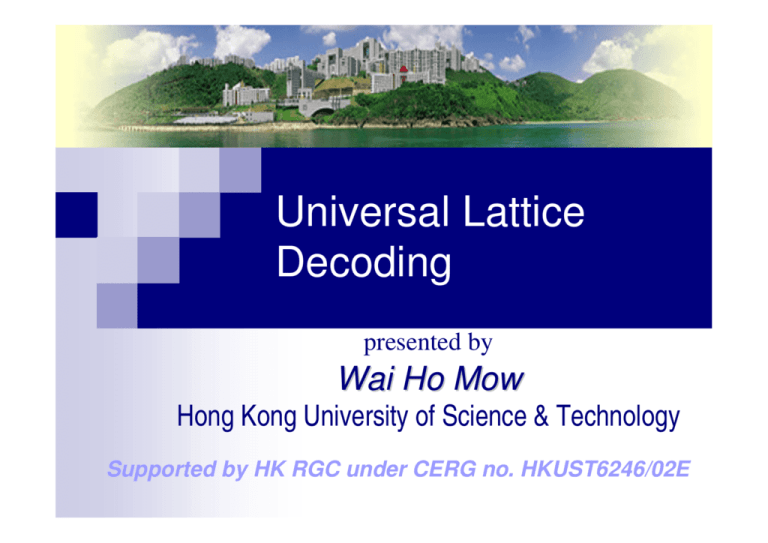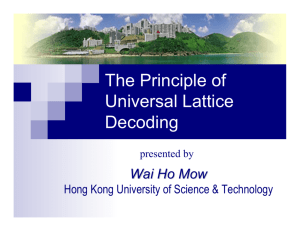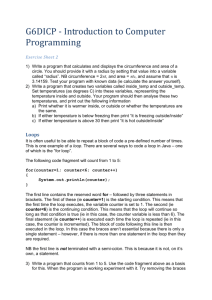Universal Lattice Decoding
advertisement

Universal Lattice
Decoding
presented by
Wai Ho Mow
Hong Kong University of Science & Technology
Supported by HK RGC under CERG no. HKUST6246/02E
Outline
Preliminaries on lattices
Universal Lattice Decoding = Closest Vector
Problem (CVP) in communications
Lattice basis reduction (e.g. LLL)
Sphere decoding (e.g. Pohst algo.)
Simulation results of Lattice-reduced sub-/optimal
detectors in MIMO fading channels
Conclusions
EEE, HKUST
presented by Wai Ho Mow
(w.mow@ieee.org)
Preliminaries on Lattices
For n ≤m, let b1, b2, …, bn be a set of
independent vectors in Rm
bi are called the basis vectors
A lattice is defined as the set of points:
{ x | x = a1b1+…+anbn }
where ai are integers
Equivalently, in matrix form:
{ x | x = Ba }
where B = [b1 … bn] and a is an integer vector
The same lattice (i.e. the same set of points)
can be generated by different basis.
EEE, HKUST
presented by Wai Ho Mow
(w.mow@ieee.org)
Closest Vector Problem (CVP)
Definition of the CVP:
Given a lattice L(B) and an arbitrary query
point q in Rm, to find, among all lattice points,
the one that is closest to q w.r.t. Euclidean
distance
More precisely, to solve:
xˆ = arg min x − q
x∈L ( B )
EEE, HKUST
presented by Wai Ho Mow
(w.mow@ieee.org)
2
CVP in Communications (1)
Many detection problems in communications can be reformulated as CVP.
Detection for MIMO fading channels (Viterbo’93, ViterboBoutros’99, Damen et al.’2000):
assuming independent flat-fading channels, the received symbol
vector y is given by:
y = Hx + w
where x := transmitted vector; H := channel matrix; w := AWGN
Sphere detector finds:
xˆ = arg min Hx − y
2
x∈Z n
thus H is the lattice basis, y is the query point.
Block-based space-time decoding (Damen’2000 & many
others) can be formulated in a similar way.
EEE, HKUST
presented by Wai Ho Mow
(w.mow@ieee.org)
CVP in Communications (2)
Lattice sequence detection for ISI channel (Mow’91 & ‘94):
Lattice sequence detector
for ISI channels
minimizes the metric:
2
~
Hu − (y − Guˆ )
where y := received seq.; G, H := Toeplitz channel matrices; := integer-valued
seq. to be detected; û := previously detected seq. Then q = y - Gû be the query
point, H be the lattice basis.
Lattice Sequence Detector
Input
+
−
Sphere Decoder
Decisions
Decision Feedback
Predictor
c.f. W.H.Mow “Maximum Likelihood Sequence Estimation from the Lattice Viewpoint”, IT-94.
Similar formulation applied to CDMA multiuser detection (Brunel et
al.’98 &’2003) and MIMO sequence detection (Vikalo-Hassibi’2002)
EEE, HKUST
presented by Wai Ho Mow
(w.mow@ieee.org)
Sub-optimal CVP Solutions
Solving CVP approximately is less difficult:
Nulling & rounding/quantization (zero-forcing)
Babai’s nearest plane algorithm (SIC: successive
interference cancellation = Babai)
Nearest plane algorithm with optimal basis ordering
(VBLAST=Ordered SIC)
These sub-optimal detectors have much lower
complexity than the optimal MLD.
EEE, HKUST
presented by Wai Ho Mow
(w.mow@ieee.org)
Optimal Solutions - MLD
How to solve CVP exactly for optimal performance?
Solving CVP in 2 steps:
1. (lattice reduction) for a given lattice, find a more
“orthogonal” basis than the original one.
2.
(sphere decoding) enumerate all lattice points inside a
sphere centered at the query point
Lattice reduction can also enhance the performance
of suboptimal schemes like ZF, SIC, etc.
Like VBLAST ordering, LLL reduction can be implemented
in the preprocessing phase.
EEE, HKUST
presented by Wai Ho Mow
(w.mow@ieee.org)
Lattice Reduction
The definition of basis reduction is not unique:
for 2-D lattices: Gauss reduction
Minkowski reduction: the shortest possible basis
Lenstra, Lenstra & Lovász (LLL or L3) reduction
LLL reduction is very important and useful in
practical applications (such as cryptanalysis) as
its complexity is only polynomial time
quartic in the lattice dimension.
EEE, HKUST
presented by Wai Ho Mow
(w.mow@ieee.org)
Sphere Decoding
Originally developed
by Pohst in 1981
To enumerate the
lattice points inside a
sphere centered at
the query point
A lattice point is
identified coordinate
by coordinate.
EEE, HKUST
presented by Wai Ho Mow
(w.mow@ieee.org)
Sphere Decoding
Sphere decoding can also
be viewed as a tree search
The radius defines a lower
upper bounds for each
dimension (level)
Once a leaf node (i.e. lattice
point) is reached, the
bounds are updated
root (level n+1)
~x
n
LBn
EEE, HKUST
presented by Wai Ho Mow
(w.mow@ieee.org)
dimension n (level n)
~x
n −1
LBn-1
The tree becomes smaller
and smaller until no leaf can
be found with the most
current bounds.
UBn
subtree rooted
at
~x
n −1
UBn-1
dimension n-1 (level n-1)
Sphere Decoding Complexity
SD complexity is sensitive to the choice of:
initial radius of the sphere (ZF, Babai/SIC, etc.)
lattice points enumeration order (SchnorrEucher order)
LLL reduction preprocessing can also
lower the SD complexity
EEE, HKUST
presented by Wai Ho Mow
(w.mow@ieee.org)
BER Performance
Simulation of a 2-transmitter
3-receiver MIMO system
using 4-PAM
Equivalent to solving CVP of
2D lattice in 6D space
LLL reduction enhances the
performance of various
suboptimal schemes
Optimal diversity is achieved
by LLL preprocessing,
consistent with simulation
results with Gauss reduction
in (Yao-Wornell 2002)
EEE, HKUST
presented by Wai Ho Mow
(w.mow@ieee.org)
BER Performance
Simulation of a 4-transmitter4-receiver MIMO system
using 64-QAM
Again LLL reduction
enhances the performance
of various suboptimal
schemes
Complex LLL
preprocessing (CLLL-ZF
etc.) can provide the same
performance by handling a
complex lattice of half the
dimension
EEE, HKUST
presented by Wai Ho Mow
(w.mow@ieee.org)
Conclusions
Many communication detection problems can be formulated
as a CVP so that the lattice approach is applicable.
Lattice basis reduction is a powerful technique for
improving the performance of known suboptimal detectors
(e.g. ZF, SIC, VBLAST), and lowering the complexity of
optimal sphere detectors, at the expense of higher
preprocessing complexity.
e.g. Very impressive performance can be obtained by
simply replace VBLAST ordering by CLLL preprocessing!
To probe further:
W.H. Mow, "Universal Lattice Decoding: Principle and Recent Advances",
Wireless Communications and Mobile Computing, Vol.3, Issue 5, August
2003, pp. 553-569.
http://www.ee.ust.hk/~eewhmow
EEE, HKUST
presented by Wai Ho Mow
(w.mow@ieee.org)








